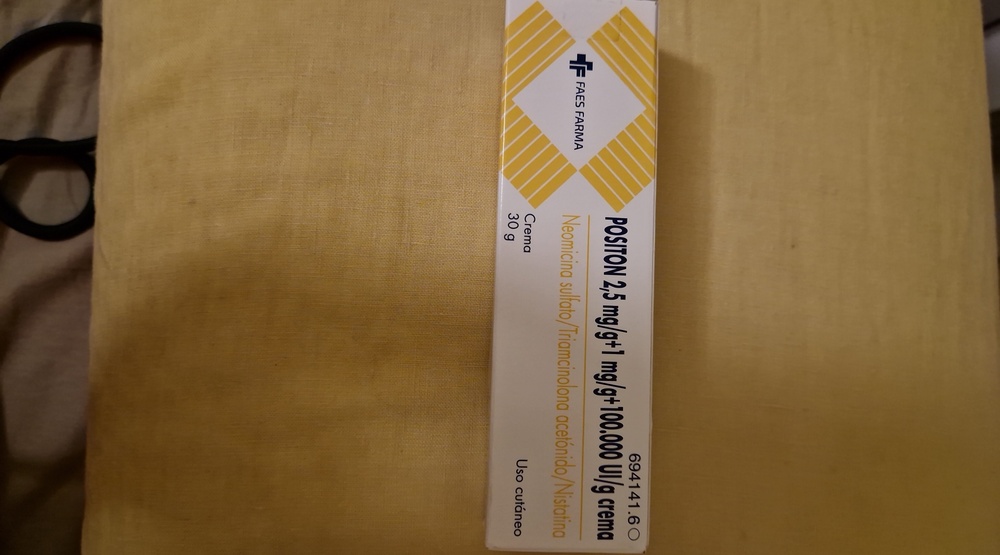

ПОЗИТОН 2,5 мг/г + 1 мг/г + 100 000 МЕ/г МАЗЬ

Спросите врача о рецепте на ПОЗИТОН 2,5 мг/г + 1 мг/г + 100 000 МЕ/г МАЗЬ

Инструкция по применению ПОЗИТОН 2,5 мг/г + 1 мг/г + 100 000 МЕ/г МАЗЬ
Введение
Инструкция: информация для пользователя
Позитон 2,5 мг/г + 1 мг/г + 100 000 ЕД/г мазь
Неомицин / Триамцинолон / Нистатин
Прочитайте внимательно всю инструкцию перед началом использования этого лекарства, поскольку она содержит важную информацию для вас.
- Сохраните эту инструкцию, поскольку вам может потребоваться перечитать ее.
- Если у вас есть какие-либо сомнения, проконсультируйтесь с вашим врачом или фармацевтом.
- Это лекарство было назначено только вам, и его не следует давать другим людям, даже если у них такие же симптомы, как у вас, поскольку оно может нанести им вред.
- Если вы испытываете побочные эффекты, проконсультируйтесь с вашим врачом или фармацевтом, даже если это побочные эффекты, которые не указаны в этой инструкции. См. раздел 4.
Содержание инструкции
- Что такое Позитон мазь и для чего она используется
- Что вам нужно знать перед началом использования Позитон мази
- Как использовать Позитон мазь
- Возможные побочные эффекты
- Хранение Позитон мази
- Содержание упаковки и дополнительная информация
1. Что такое Позитон мазь и для чего она используется
Это комбинация антибиотика аминогликозида, противовоспалительного препарата (кортикостероида) и противогрибкового препарата для применения на коже.
Позитон мазь относится к группе лекарств, называемых местными кортикостероидами. Слово «местный» означает, что оно наносится на кожу.
Позитон мазь также содержит неомицин, антибиотик для предотвращения или лечения некоторых бактериальных инфекций кожи, и нистатин, противогрибковый препарат для лечения кожных инфекций, вызванных грибами.
Антибиотики используются для лечения бактериальных инфекций и не подходят для лечения вирусных инфекций.
Важно следовать инструкциям относительно дозы, интервала применения и продолжительности лечения, указанным вашим врачом.
Не храните и не повторно используйте это лекарство. Если после окончания лечения у вас осталось антибиотик, верните его в аптеку для правильной утилизации. Не следует выбрасывать лекарства в канализацию или мусор.
Позитон мазь используется для лечения дерматологических процессов, чувствительных к кортикостероидам, при которых существует или есть риск бактериальной или грибковой инфекции.
Вам следует проконсультироваться с врачом, если ваше состояние ухудшится или не улучшится после 7 дней.
2. Что вам нужно знать перед началом использования Позитон мази
Не используйте Позитон мазь
- Если вы аллергичны к неомицину, триамцинолону или нистатину или к любому другому компоненту этого лекарства (указанному в разделе 6).
- Если у вас розацеа (заболевание кожи, сопровождающееся покраснением лица), воспаление вокруг рта (перIORALная дерматит), акне, зуд генитальной или анальной области, воспалительные процессы кожи, вызванные вакцинацией (вакцинальные кожные реакции), атрофические заболевания кожи.
- Если у вас кожные инфекции, вызванные туберкулезом или вирусами, такими как простой герпес или ветрянка.
- Не следует использовать при дерматозах у детей младше 1 года, поскольку существует более высокий риск увеличения абсорбции.
Предостережения и меры предосторожности
Проконсультируйтесь с вашим врачом или фармацевтом перед началом использования Позитон мази.
- Используйте это лекарство только на вашей коже.
- Не допускайте контакта с глазами, слизистыми оболочками и открытыми ранами, поскольку это может вызвать раздражение.
- Избегайте покрытия обработанной области повязками, подгузниками или пластырями.
- Не используйте Позитон мазь на обширных участках кожи, если только ваш врач не указал это.
- Не наносите Позитон мазь на лицо или на участки кожи, подверженные трению, такие как пах, или другие участки кожи (например, участки сгиба между руками и ногами). Не используйте Позитон мазь на язвах, ранах или растяжках.
- Если возникает сильное раздражение или сухость, проконсультируйтесь с вашим врачом.
- Не рекомендуется использовать при псориазе пустулезного типа или при гуттате.
- Свяжитесь с вашим врачом, если у вас出现ится размытое зрение или другие нарушения зрения.
Дети и подростки
Безопасность и эффективность Позитон мази у детей не установлены.
Использование этого лекарства у детей и подростков будет осуществляться только тогда, когда, по мнению врача, будет доказана необходимость его использования.
Лечение у детей должно быть тщательно контролируемо врачом, особенно если оно наносится на обширные участки кожи или если используется окклюзивная повязка или плотно прилегающий подгузник.
Следует избегать постоянного и длительного местного лечения, особенно у детей, поскольку это может привести к подавлению гипоталамо-гипофизарно-надпочечниковой оси с возникновением или без возникновения синдрома Кушинга. Если это произойдет, проконсультируйтесь с вашим врачом, поскольку лекарство должно быть отменено постепенно и под медицинским контролем из-за риска надпочечной недостаточности.
Использование Позитон мази с другими лекарствами
Сообщите вашему врачу или фармацевту, если вы используете, недавно использовали или можете использовать любое другое лекарство, включая те, которые можно купить без рецепта. Также учитывайте любое лекарство, которое используется на коже.
Если вы принимаете перорально или парентерально антибиотики из той же группы, что и неомицин, токсичность может накапливаться.
Беременность, лактация и фертильность
Проконсультируйтесь с вашим врачом или фармацевтом перед использованием любого лекарства.
Если вы беременны или кормите грудью, считаете, что можете быть беременной или планируете стать беременной, проконсультируйтесь с вашим врачом или фармацевтом перед использованием этого лекарства.
Беременность
Использование Позитон мази во время беременности следует избегать.
Если вы становитесь беременной во время лечения этим лекарством, немедленно проконсультируйтесь с вашим врачом.
Лактация
Использование Позитон мази во время лактации не рекомендуется, если только это не абсолютно необходимо.
Вождение и использование машин
Это лекарство не влияет на способность управлять транспортными средствами или работать с машинами.
3. Как использовать Позитон мазь
Следуйте точно инструкциям по применению этого лекарства, указанным вашим врачом или фармацевтом. В случае сомнений проконсультируйтесь снова с вашим врачом или фармацевтом.
Взрослые
Нанесите тонкий слой Позитон мази мягко на пораженный участок кожи 2-3 раза в день. Нанесение большего количества не улучшит результаты. Нанесите мазь пальцами на пораженный участок кожи. Убедитесь, что вы хорошо моете руки водой и мылом после нанесения лекарства, чтобы оно не попало в глаза или нос случайно, поскольку это может вызвать раздражение.
Для использования мази открутите крышку от тюбика и, с помощью наконечника на внешнем конце, проколите металлическое отверстие.
Ваш врач определит продолжительность лечения. Не используйте Позитон мазь в течение более длительного периода, чем назначено.
Использование у детей и подростков
Использование этого лекарства у детей и подростков будет осуществляться только тогда, когда, по мнению врача, будет доказана необходимость его использования, и в этом случае наносится тонкий слой один раз в день, не превышая 7 дней лечения.
Если используется у детей, лечение должно быть тщательно контролируемо врачом, что особенно важно, если лекарство наносится на обширные участки кожи или если используются окклюзивные повязки или плотно прилегающие подгузники.
Если вы используете больше Позитон мази, чем следует
Если вы используете слишком много Позитон мази или если вы используете ее в течение длительного периода, часть лекарства может быть абсорбирована организмом и вызвать нежелательные эффекты.
Сообщите вашему врачу, если вы испытываете какой-либо нежелательный эффект, такой как необычная усталость или если вы испытываете любой другой изменение.
В случае передозировки или случайного приема проконсультируйтесь немедленно с вашим врачом или фармацевтом или позвоните в Службу токсикологической информации, телефон 915620420, указав лекарство и количество, использованное.
Если вы забыли использовать Позитон мазь
Нанесите лекарство как можно скорее, затем вернитесь к обычному режиму применения.
Не используйте двойную дозу для компенсации пропущенных доз.
Если вы прекратите лечение Позитон мазью
Если вы используете ее так, как обычно назначено, не должно быть эффектов отмены при прекращении лечения Позитон мазью.
Если вы использовали большие количества Позитон мази в течение длительного периода, ваш врач укажет, как уменьшить это лекарство, чтобы ваш организм мог адаптироваться.
Если у вас есть какие-либо сомнения относительно использования этого лекарства, проконсультируйтесь с вашим врачом или фармацевтом.
4. Возможные побочные эффекты
Как и все лекарства, это лекарство может вызвать побочные эффекты, хотя не все люди испытывают их.
Частота, с которой могут возникать побочные эффекты, классифицируется следующим образом:
Очень часто (могут возникать у более 1 из 10 человек).
Часто (могут возникать у до 1 из 10 человек).
Не часто (могут возникать у до 1 из 100 человек).
Редко (могут возникать у до 1 из 1000 человек).
Побочные эффекты с неизвестной частотой (не может быть оценено на основе доступных данных).
Очень частые побочные реакции | Реакции гиперчувствительности (особенно если используется в течение длительных периодов), включая: контактный дерматит, жжение, эритему, сыпь и крапивницу. |
Частые побочные реакции | Чувство жжения от легкого до умеренного в месте применения, зуд (чувство покалывания), местная атрофия кожи, боль, щипание, раздражение, воспаление или эритема кожи в месте применения, что обычно не требует прекращения лечения. |
Нечастые побочные реакции | Стрии, вторичные инфекции, розацеа-подобный папулезный дерматит лица, экхимозы (появление небольших кровоизлияний на коже), фолликулит, эритема, зуд (чувство покалывания), чувство жжения. |
Редкие побочные реакции | Гипертрихоз, сенсибилизация, гипер-/гипопигментация (изменения цвета кожи), телянгиектазии (расширение мелких кровеносных сосудов кожи), гиперкортицизм, подавление коры надпочечников, анафилактические реакции, контактный дерматит, перIORALный дерматит, системная активность. В редких случаях лечение псориаза кортикостероидами может привести к развитию пустулезной формы заболевания. |
Побочные реакции с неизвестной частотой | Размытое зрение. |
Другие побочные эффекты включают: пурпуру, акне (особенно при длительном лечении).
Проконсультируйтесь с вашим врачом немедленно, если вы испытываете любой из следующих симптомов: появление сыпи или эритемы на коже, трудности с дыханием или глотанием, свистящее дыхание или кожные инфекции (покраснение, воспаление или гной).
Сообщение о побочных эффектах
Если вы испытываете любой побочный эффект, проконсультируйтесь с вашим врачом или фармацевтом, даже если это возможные побочные эффекты, которые не указаны в этой инструкции. Также вы можете сообщить об этом напрямую через Систему фармакологической безопасности лекарств для человека: www.notificaRAM.es. Сообщая о побочных эффектах, вы можете внести свой вклад в предоставление более полной информации о безопасности этого лекарства.
5. Хранение Позитон мази
Храните это лекарство в недоступном для детей месте.
Это лекарство не требует специальных условий хранения.
Не используйте это лекарство после даты истечения срока годности, указанной на упаковке после CAD. Дата истечения срока годности - последний день месяца, указанного.
Не используйте Позитон мазь, если вы заметите любой видимый признак повреждения. Сообщите вашему врачу или фармацевту, если вы заметите любой изменение внешнего вида Позитон мази.
Лекарства не должны выбрасываться в канализацию или мусор. Поместите упаковку и лекарства, которые вам больше не нужны, в Пункт SIGRE аптеки. В случае сомнений проконсультируйтесь с вашим фармацевтом, как избавиться от упаковки и лекарств, которые вам больше не нужны. Таким образом, вы поможете защитить окружающую среду.
6. Содержание упаковки и дополнительная информация
Состав Позитон мази
- Активные вещества: сульфат неомицина, ацетонид триамцинолона и нистатин. Каждый грамм мази содержит 2,5 мг сульфата неомицина, 1 мг ацетонида триамцинолона и 100 000 ЕД нистатина.
- Другие компоненты: пластобаз (полietilen, бакелит и минеральное масло).
Внешний вид продукта и содержание упаковки
Позитон мазь выпускается в алюминиевых тюбиках, содержащих 30 г или 60 г мази.
Владелец разрешения на продажу
Faes Farma, S.A.
Автономия Эторбидеа, 10
48940 Леоа (Бискайя)
Испания
Производитель
Faes Farma Португалия, S.A.
Руа Элиас Гарсия 28
2700-327 Амадора
Португалия
Дата последнего пересмотра этой инструкции:Февраль/2018
Подробная и актуальная информация о этом лекарстве доступна на сайте Агентства по лекарствам и медицинским изделиям Испании (AEMPS) http://www.aemps.es./
- Страна регистрации
- Активное вещество
- Требуется рецептДа
- Производитель
- Информация носит справочный характер и не является медицинской рекомендацией. Перед приемом любых препаратов проконсультируйтесь с врачом. Oladoctor не несет ответственности за медицинские решения, принятые на основе этого контента.
- Аналоги ПОЗИТОН 2,5 мг/г + 1 мг/г + 100 000 МЕ/г МАЗЬФорма выпуска: МАЗЬ, 0,350 г / 0,100 гАктивное вещество: triamcinolone and antibioticsПроизводитель: Laboratorio Aldo Union S.L.Требуется рецептФорма выпуска: КРЕМ, -Активное вещество: triamcinolone and antibioticsПроизводитель: Faes Farma S.A.Требуется рецептФорма выпуска: КРЕМ, 0,25 мг / 5 мгАктивное вещество: fluocinolone acetonide and antibioticsПроизводитель: Galenicum Derma S.L.U.Требуется рецепт
Аналоги ПОЗИТОН 2,5 мг/г + 1 мг/г + 100 000 МЕ/г МАЗЬ в других странах
Лучшие аналоги с тем же действующим веществом и терапевтическим эффектом.
Аналог ПОЗИТОН 2,5 мг/г + 1 мг/г + 100 000 МЕ/г МАЗЬ в Польша
Аналог ПОЗИТОН 2,5 мг/г + 1 мг/г + 100 000 МЕ/г МАЗЬ в Украина
Врачи онлайн по ПОЗИТОН 2,5 мг/г + 1 мг/г + 100 000 МЕ/г МАЗЬ
Консультация по дозировке, побочным эффектам, взаимодействиям, противопоказаниям и продлению рецепта на ПОЗИТОН 2,5 мг/г + 1 мг/г + 100 000 МЕ/г МАЗЬ – по решению врача и с учетом местных правил.






